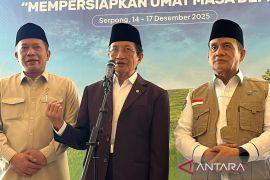JSS, as Sunda Strait Bridge is called, is expected to boost connectivity and logistics transport between the countrys two most densely populated islands of Java and Sumatra.
Under the master plan for the Acceleration and Expansion of Indonesias Economic Development (MP3EI) program, the planned 30-km bridge is among the major infrastructure projects the government wants to implement.
"The construction of the JSS mega project will continue, despite a change in government," Coordinating Economic Minister Hatta Rajasa remarked here on Wednesday.
He noted that there has been a presidential regulation about the project, and therefore, the construction will continue even after the next government comes into power.
In 2011, President Susilo Bambang Yudhoyono issued Regulation No.86 on the development of the Sunda Strait Infrastructure Strategic Zone to support the construction of the bridge and the development of the surrounding areas in Banten and Lampung.
Hatta had explained that it is a must to construct the bridge, as it will serve as gateway of land transportation into Sumatra Island to help boost the Indonesian economy.
According to him, the construction of the bridge is also expected to overcome congestion in the distribution of agricultural crops across the two islands.
He pointed out that there is a dire need to construct the bridge because of the increasing number of vehicles, due to which, the roll on-roll off (ro-ro) ships fail to maximally transport them.
Meanwhile, Public Works Minister Djoko Kirmanto stated on Wednesday that the government will soon appoint the executive board for the construction of the JSS mega project.
"The construction of the Sunda Strait Bridge is very important, and thus the executive body responsible for the project will be appointed by the government soon," Djoko emphasized after attending a coordination meeting.
He explained that everything related to the construction of the bridge will be done in accordance with the Presidential Regulation (Perpres) No.86/2011 on the development of strategic areas and infrastructure of the Sunda Strait.
"Basically, we will continue to use the Perpres No.86/2011, but there will be a change and revision in the Terms of Reference (TOR) concerning the initiator of the project in order to make it more transparent and measurable," Djoko explained.
According to him, the executive body will be responsible for the arrangement and setting up of the development plan, the program and the development according to the feasibility study done on strategic areas and infrastructure of the Sunda Strait bridge.
Besides this, he added that the executive body will be the authority of the government to facilitate one-roof service for licensing, to coordinate with relevant institutions, to plan acquisition, and to draw up and manage the budget of the development agency.
"The executive body is necessary because it will sign a contract with private parties. We have decided to go ahead with the Sunda Strait Bridge project because it is part of the MP3EI," Djoko explained.
The idea of building a bridge spanning the strait separating the islands of Java and Sumatra dates back to the time under the administration of first President Soekarno, after which, a serious plan inspired by the idea was made under President Suharto.
Last year, Djoko Kirmanto had stated that the ministry was in the final phase of drafting a cooperation agreement between the government and a consortium to build the project.
Earlier, planning consultants Wiratman & Association estimated that the project, which includes development of areas at both ends of the bridge, will cost US$25 billion.
Construction of the 30-kilometer bridge will cost US$10 billion and development of the areas at both end of the bridge will cost around US$15 billion.
Coordinating Economic Minister Hatta Rajasa stated in July last year that a series of feasibility studies on the mega project indicated that the bridge was technically possible to be built.
The minister added at the time that the feasibility studies on the bridge were related to its resistance to earthquake, volcanic activity, and sea current.
"The feasibility studies indicated that when constructed, the Sunda strait bridge will remain safe from possible Krakatu volcanic eruption and tsunami," he noted.
Hatta pointed out that the Sunda strait bridge will be built as an icon in Indonesia where the local engineers and experts will play a dominant role in the construction.
He explained that the bridge will be built in an integrated zone, covering the provinces of Lampung and Banten.
Rapid economic growth in Java needs support from adequate transport facility and the development of the JSS project is a solution.
The JSS will solve the problem faced in ferry transport such as frequent long queue of cargo trucks and passenger cars in waiting for their turn to be ferried across Sunda strait.
Based on data from the Central Bureau of Statistic (BPS), Java and Sumatra accounted for 78 percent of the country's GDP in 2010, and inadequate infrastructure still poses a problem in both Java and Sumatra.
Therefore the Sunda Strait Bridge will be much more efficient and transport will not be hampered by bad weather or big waves, when one is sailing in the sea.
Meanwhile, Development Planning Agency Deputy Minister for Infrastructure Dedy Priatna stated that the groundbreaking of the project could not be expected in 2014.
"Not this year, but we hope the new government from the upcoming 2014 presidential election will go ahead with the project to boost the investment climate in Indonesia," he noted. (*)
Reporter: Otniel Tamindael
Editor: Otniel Tamindael
Copyright © ANTARA 2014











